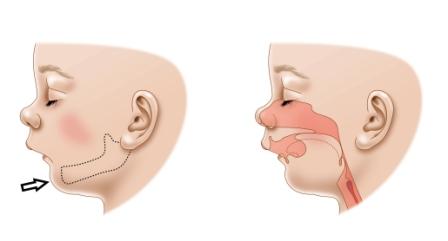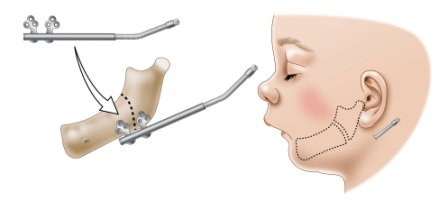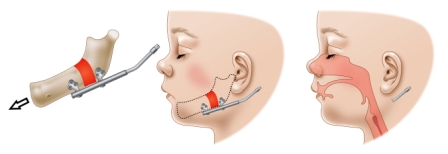Jaw distraction is the name for a surgical method of lengthening a small or recessed (hollow or indented) jaw. The medical term for jaw distraction is mandibular distraction osteogenesis (man-dib-u-lar dis-track-shon osti-oh-jen-esis).
A small or recessed jaw can cause severe or ongoing breathing difficulties. Jaw distraction involves the surgical insertion of distraction (lengthening) devices into the jaw. These devices lengthen the jaw bone, which allows the airway to open up and
the child to breathe clearly.
This procedure is only used in cases of severe, life-threatening breathing problems, and will not be undertaken to correct facial shape alone.
Jaw distraction surgery is a very successful way of easing breathing problems, and can prevent the need for a tracheostomy in most cases (see our fact sheet Tracheostomy). Jaw distraction
is proven to be a much safer alternative to tracheostomy in infants.
Why does my child need a jaw distraction?
Some children are born with a very small or recessed lower jaw.

In most cases this does not cause any problems, but in a small number of infants it can cause serious problems in the first few months of life. This is mostly due to the tongue moving back into the throat when the child breathes in, blocking the airway.
This is known as upper airway obstruction, and can cause serious disruption to breathing and feeding.
If your child has an upper airway obstruction, they will need to stay in hospital for a period of time so their breathing can be monitored and assessed. During this time, non-surgical methods of improving the airway obstruction will be tried, such as
the insertion of a nasopharyngeal (nay-zo-far-an-jeel) tube (a tube down the nose that improves air flow to the breathing tubes and lungs).
In a very small number of cases, these non-surgical methods are not successful and a child's breathing problems become life threatening. In other instances, the non-surgical methods may be required for a very long time, and this can be very difficult
to sustain. In either of these cases, jaw distraction might be the best treatment.
What do I need to know?
Before surgery
You will be given instructions from your doctor or nurse on fasting before the surgery. It’s important to follow these directions.
Your child will have a general anaesthetic to put them to sleep before the surgery. The surgeon, anaesthetist (a doctor who puts your child to sleep during the operation) and nurses will explain all the procedures to you before they begin. If you have
any questions or anything is unclear, ask staff to explain as many times as needed.
During surgery
The surgery takes about two to three hours. An incision (cut) is made through the skin under the jaw line, and then the jaw bone is carefully separated so a distraction device can be attached to the bone. This happens on each side of the jaw.
The distraction device is not visible after the operation, except for two small rods (called distractor arms) that will protrude (stick out) out from the chin or from behind the jaw line.

After surgery
The day after surgery, each distractor arm will be turned a full 360 degrees. This procedure is repeated every eight hours for about 10 days. During the eight hours between turns, your child's jawbone will grow to fill the space.
This gradually lengthens the jaw bone, allowing the tongue to move away from the back of the throat. This in turn makes the airway larger, and breathing will become easier (see figure below).

Your child will need to stay in hospital until their airway has opened up and they are breathing clearly and without assistance.
Care at home
The distraction device will stay in place for around six to eight weeks to support the new bone as it gains more strength. During this time your child can be at home and will be breathing and feeding normally. There should not be much disruption to daily
life.
- The distractors are made of flexible titanium and there should not be a problem if they are knocked or grasped by your child.
- Take care to keep the area around the distractor arms clean to help prevent an infection.
- If you have any problems with the distraction device, or if you notice any signs of infection such as redness, pain or swelling, contact your doctor immediately.
Follow-up
Follow-up appointments will be made with the doctors and surgeons involved in the jaw distraction process during your child's stay in hospital.
The distraction device will be removed once the bone is strong enough. This involves another surgery, and your child will need to stay in hospital for another one or two nights.
Key points to remember
- Wherever possible, non-surgical methods to ease airway obstruction will be tried to avoid surgery on a small infant.
- Jaw distraction is proven to be a much safer alternative to tracheostomy in an infant with severe upper airway obstruction.
- Jaw distraction will not be undertaken to correct facial shape alone.
- The distraction device will stay in place for around six to eight weeks to support the new bone.
For more information
Common questions our doctors are asked
What are the risks of jaw distraction surgery?
There are very few risks involved in a jaw distraction procedure. The risks of a tracheostomy or leaving an airway obstruction untreated are much higher. The risks specific to jaw distraction include infection, sensory disturbance in the face, damage
to teeth or faint scarring.
Call an ambulance (000) immediately in an emergency.
Developed by The Royal Children's Hospital Plastic and Maxillofacial Surgery, Respiratory Medicine and Paediatric and Neonatal Surgery departments. We acknowledge the input of RCH consumers and carers.
Reviewed May 2018.
This information is awaiting routine review. Please always seek the most recent advice from a registered and practising clinician.